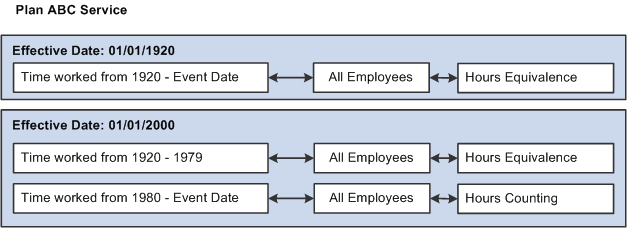Time Segments and Function Results
Certain functions sometimes apply different rules over different periods of an employee's career. For example, an employee may have accrued service using an hours counting method until a plan amendment in 1980, then started accruing service using an hours equivalence method. You don't want the system to recalculate the earlier service using the changed rules; rather, you want to add the service accrued under the old rules and that accrued under the new rules. That is, the rules are simultaneously effective, but over different time segments.
This graphic illustrates the preceding scenario where time segments are used to implement different service accrual methods over different parts of an employee’s work history.

On the Function Result page, you indicate the applicable time segment using the Start Date and Stop Date fields. The Stop Date for the final time segment is normally the event date, which is the date of separation from service due to termination or retirement.
Only specific functions deal with multiple simultaneously effective time segments:
|
Function |
Example |
|---|---|
|
Consolidated contributions Consolidated earnings Consolidated hours |
If consolidation rules change, the consolidated hours, earnings, and contributions for previous years can remain unchanged; the new rules are used only for future periods. |
|
Service |
Service accrued prior to the rule change remains unaltered. Additional service accrual is based on the new rules. Results from each time segment are added together. |
|
Cash balance accounts |
If the cash balance rules change, the prior balance isn't affected, but future accruals are based on the new rules. Results from each time segment are added together. |
|
Employee accounts |
If the employee account rules change, the prior balance isn't affected, but future accruals are based on the new rules. Results from each time segment are added together. |
|
Death coverage factors |
If the death coverage rules change, the reduction that the employee has already incurred for coverage up to that point remains and any additional reduction is calculated using the new rules. Results from each time segment are added together. |
|
Participation |
If participation rules change, the participation status for prior years remains unchanged. The new rules only apply to future periods. |
Other functions don't use time segments to break an employee's career into sections. Therefore, the Start Date and Stop Date fields always use values that define a time segment encompassing the entire life of the plan. For example, all time segments for vesting could use the dates January 1, 1900 to event date.